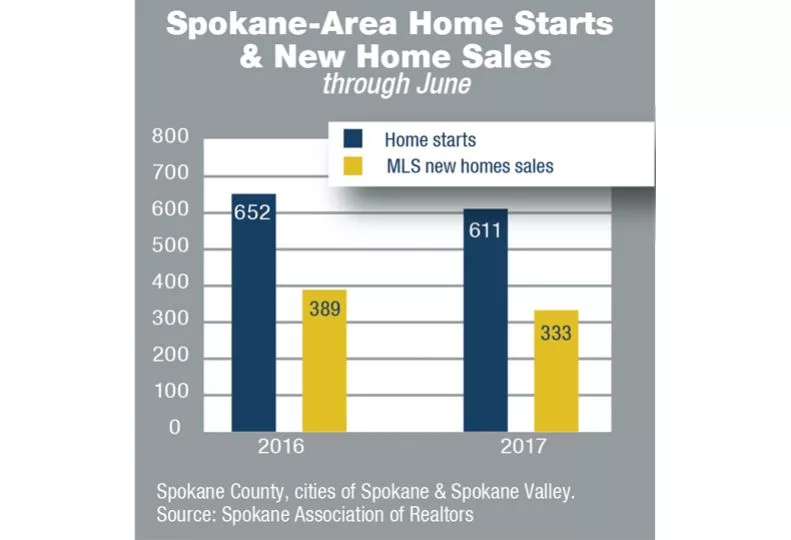Labor shortage slows Spokane homebuilders
Lack of available lots also said hindering construction

Despite strong growth in existing home sales for the first half of the year, new home sales and construction are lagging behind last year’s pace, homebuilding industry observers say.
But that lag isn’t due to a lack of demand, they say, pointing out that prices continue to climb. Rather, the slowdown is caused by a tight labor market and a shortage of land to build upon.
In the first six months of this year, 389 newly built homes were sold through the Spokane Association of Realtors Multiple Listing Service, down more than 14 percent compared with new home sales for the first six months of 2016, says Rob Higgins, executive vice president of the association.
“The demand is there,” Higgins says. “Housing construction is lagging behind, especially on lower-end starter homes.”
The average price of newly built homes sold through the MLS for the first half of the year was $317,820, up nearly 11 percent compared with the first half 2016 average sales price of $286,800.
Joel White, executive officer of the Spokane Home Builders Association, says the long winter contributed to a slow start to the building season.
“Home construction is taking longer because of a labor shortage, and builders are scrambling to finish houses they committed to last fall,” White says. “If we had the labor, there would be more homes going into the ground.”
Building permits issued for single-family homes in Spokane County and the cities of Spokane and Spokane Valley totaled 611 units, a drop of more than 6 percent compared with permits issued in the first half of 2016.
Conversely, average valuations continued to climb. The average valuation for single-family home permits this year through June was $260,100, up nearly 6 percent compared with the year-earlier average.
Corey Condron, owner of longtime Spokane homebuilding company Condron Homes LLC, says the company is having a good year, but can’t grow because of the land and labor shortages.
“We have no plans to expand the company to accept more of the market demand,” he says. “We can barely find enough land and labor to meet our goals the way the company is structured now.”
Condron says the company anticipates building 45 homes this year.
“It’s a great year for us,” he says. “But we’re at maximum capacity.”
Most subcontractors also are facing a labor shortage, he says, “So, they can’t help us expand.”
Condron says the Spokane Home Builders Association is participating in education and training programs aimed at attracting new workers to the construction trades.
“We just need the younger generation to fill the gap,” he says.
White says one builder has withdrawn a planned entry from the association’s upcoming 2017 Fall Festival of Homes because of the workforce shortage.
As it stands now, the annual Fall Festival, which showcases local builders’ newly constructed homes, will be smaller this year than most because of lack of inventory.
“Hopefully, we won’t lose any more,” White says. “Houses are selling really fast. As soon as builders put in foundations, people are putting offers on houses.”
Along with workforce issues, some builders are worried about where they can find the next parcel of land to build on, he says.
Much of the land available in Spokane is scattered infill lots, which tend to cost more to develop than clustered vacant lots.
“There’s not a lot of land available on the outskirts of town,” White adds.
The Washington Supreme Court’s 2016 Whatcom County vs. Hurst ruling is limiting development in some rural areas, he says.
Through the ruling, the court has determined new wells would be prohibited near protected rivers and streams, according to the state Department of Ecology.
In much of the Little Spokane River watershed for instance, the decision essentially prohibits development on land lacking established wells where there’s no municipal water service, White asserts.
“If you’re not allowed to put in a well, it turns potentially developable land with big majestic views into just a fun place to walk through,” he says.
Seattle-based economic and public policy consultant Michael Luis says labor shortages in bigger markets are exacerbating the problem in Spokane.
“If I’m a house framer in Spokane and I can make twice as much in Seattle, I’m going there,” he says.
The Spokane Association of Realtors has hired Luis to conduct a year-long study to determine how current land availability affects the Spokane-area homebuilding industry and the residential real estate market.
The Washington state Growth Management Act requires counties and cities to establish urban growth boundaries to encourage infill development and limit urban sprawl.
The act also requires that the urban growth boundaries accommodate anticipated population growth looking ahead 20 years.
Luis says the Spokane Association of Realtors study indicates the amount of land that’s been designated as available for development inside the Spokane-area urban growth boundaries is overstated.
He contends a significant portion of the land designated as available isn’t developable economically.
“There’s a lot of small parcels that are hard to work with,” he says. “Also, Spokane has a lot of rock, and it’s expensive to build on rock.”
Another finding of the study is that there are few large tracts of land available for development, he says.
“Developers like to work with large parcels,” Luis says. “Not many large parcels are left, and some are awkwardly configured.”
Although home prices are rising, the Spokane market is price-constrained compared with other active housing markets, he says.
“You can only build and sell so many expensive houses in the Spokane area,” Luis says. “As the cost of developing land goes up, builders get squeezed and can’t get a product on the market at a price people are willing to pay.”
Higgins says some tracts of land identified as available for development within the urban growth boundaries simply aren’t for sale.
“Land that is developable is tied up, and some who’ve tied up the land aren’t building as robustly as in the past,” he says.
The Spokane Association of Realtors will release Luis’ study findings at a meeting tentatively scheduled for Sept. 8, along with a building trades report from the Spokane Home Builders Association.
The meeting also will feature a keynote address by Lawrence Yun, chief economist for the National Association of Realtors.
Related Articles
Related Products


_c.webp?t=1763626051)

_web.webp?t=1764835652)
